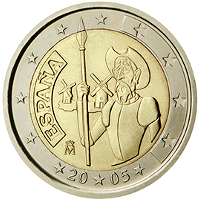 |
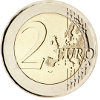 |
C o m m e m o r a t i v e
C o i n s |
||
| Spain | |||||||
The edge lettering of the Spanish 2‐euro‐commemorative coins is : |
 |
||||||
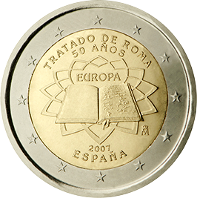 🔎
🔎 |
 |
Spain | 25 Mar. 2007 | 50th anniversary of the Signature of the Treaty of Rome |
20001 20002 20005 |
8,000,000 |  |
National characteristics : At the top are the words "TRATADO DE ROMA" (Treaty of Rome) and "50 ANOS" (50 years), below it is an illustration of the treaty with the words "EUROPA", below that is the year "2007" and the country name "ESPAÑA" (Spain). To the right of the document is the letter "M" adorned with a crown, the mint mark of the Spanish mint Real Casa de la Moneda in Madrid. |
|||||||
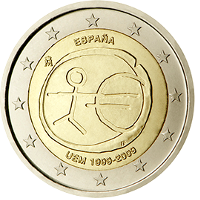 🔎
🔎 |
 |
Spain | 02 Feb. 2009 | 10th anniversary of the Economic and Monetary Union (EMU) |
20001 20002 20005 |
8,000,000 |  |
National characteristics : Above is the name of the issuing country "ESPAÑA" (Spain), the acronym of the occasion of issue below is "UEM". The letter "M" adorned with a crown, the mint mark sign of the Spanish mint Real Casa de la Moneda in Madrid is shown on the left. |
|||||||
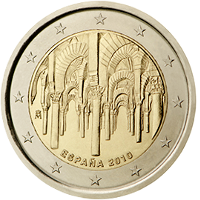 🔎
🔎 |
 |
Spain | 03 Mar. 2010 | Historic Centre of Córdoba (Mezquita‐Cathedral) 1st coin in the UNESCO World Heritage Sites series |
20001 20002 20005 |
4,000,000 |  |
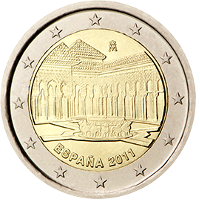 🔎
🔎 |
 |
Spain | 21 Feb. 2011 | Patio de los Leones of the Alhambra, Generalife and Albayzín, Granada 2nd coin in the UNESCO World Heritage Sites series |
20001 20002 20005 |
4,000,000 |  |
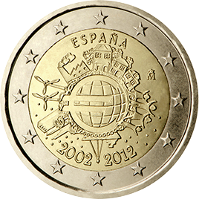 🔎
🔎 |
 |
Spain | 02 Jan. 2012 | 10th anniversary of the Euro‐Currency |
20001 20002 20005 |
4,000,000 |  |
National characteristics : At the top of the coin is the name of the issuing country "ESPAÑA" (Spain). On the right between the images of residential houses and family is the letter "M" adorned with a crown, the mint mark of the Spanish mint Real Casa de la Moneda in Madrid. |
|||||||
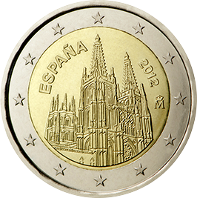 🔎
🔎 |
 |
Spain | 01 Mar. 2012 | Burgos Cathedral 3rd coin in the UNESCO World Heritage Sites series |
20001 20002 20005 |
4,000,000 |  |
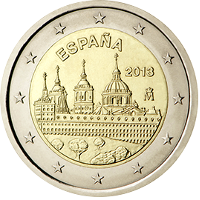 🔎
🔎 |
 |
Spain | 02 Mar. 2013 | Monastery and Site of the El Escorial, Madrid 4th coin in the UNESCO World Heritage Sites series |
20001 20002 20005 |
4,000,000 |  |
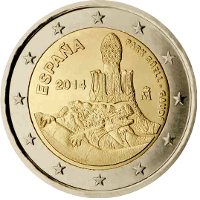 🔎
🔎 |
 |
Spain | 07 Feb. 2014 | Works of Antoni Gaudi (Park Güell) 5th coin in the UNESCO World Heritage Sites series |
20001 20002 20005 |
4,000,000 |  |
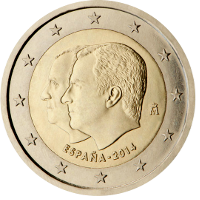 🔎
🔎 |
 |
Spain | 10 Dec. 2014 | King Felipe VI's accession to the thone |
20001 20002 20005 |
8,132,500 |  |
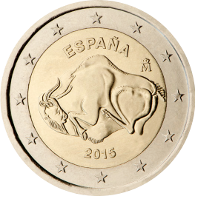 🔎
🔎 |
 |
Spain | 30 Jan. 2015 | Cave of Altamira and Paleolithic Cave Art of Northern Spain 6th coin in the UNESCO World Heritage Sites series |
20001 20002 20005 |
4,104,700 |  |
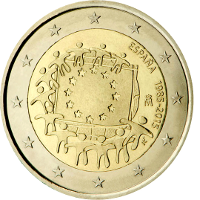 🔎
🔎 |
 |
Spain | 01 Dec. 2015 | 30th anniversary of the EU‐Flag |
20001 20002 20005 |
4,300,000 |  |
National characteristics : Above is the name of the issuing country "ESPAÑA" (Spain), followed by the dates "1985‐2015". On the right hand side of the motif is the letter "M" adorned with a crown, the mint mark of the Spanish mint Real Casa de la Moneda in Madrid. |
|||||||
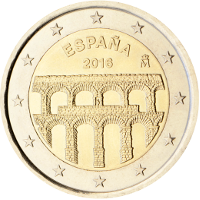 🔎
🔎 |
 |
Spain | 05 Feb. 2016 | Old town of Segovia and its aqueduct 7th coin in the UNESCO World Heritage Sites series |
20001 20002 20005 |
3,400,000 |  |
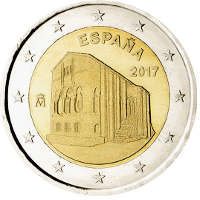 🔎
🔎 |
 |
Spain | 03 Feb. 2017 | Monuments of Oviedo and the Kingdom of Austurias (Santa Maria del Naranco) 8th coin in the UNESCO World Heritage Sites series |
20001 20002 20005 |
536,520 |  |
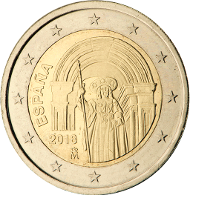 🔎
🔎 |
 |
Spain | 02 Feb. 2018 | Old town of Santiago de Compostela 9th coin in the UNESCO World Heritage Sites series |
20001 20002 20005 |
333,700 |  |
 🔎
🔎 |
 |
Spain | 02 Feb. 2018 | 50th birthday of Felipe VI of Spain |
20001 20002 20005 |
431,500 |  |
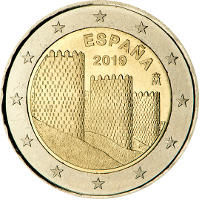 🔎
🔎 |
 |
Spain | 01 Feb. 2019 | Old town of Ávila with its extra‐muros churches 10th coin in the UNESCO World Heritage Sites series |
20001 20002 20005 |
500,000 |  |
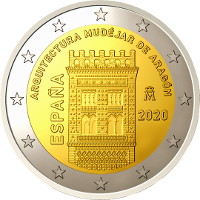 🔎
🔎 |
 |
Spain | 31 Jan. 2020 | Mudéjar Architecture of Aragon 11th coin in the UNESCO Wourld Heritage Sites series |
20002 20007 20008 |
4,024,500 |  |
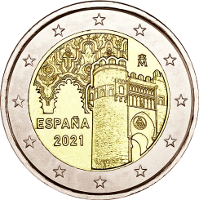 🔎
🔎 |
 |
Spain | 10 Mar. 2021 | Historic city of Toledo 12th coin in the UNESCO Wourld Heritage Sites series |
20002 20007 20008 |
4,019,500 |  |
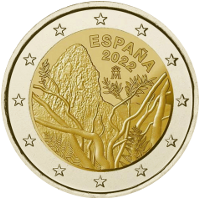 🔎
🔎 |
 |
Spain | 23 Mar. 2022 | Garajonay National Park 13th coin in the UNESCO Wourld Heritage Sites series |
20003 20005 |
1,019,300 |  |
 Work in progress |
|||||||
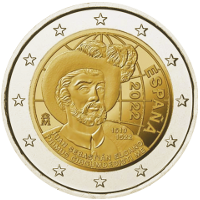 🔎
🔎 |
 |
Spain | 23 Mar. 2022 | 500th anniversary of the completion of the first circumnavigation |
20003 20005 |
1,019,000 |  |
 Work in progress |
|||||||
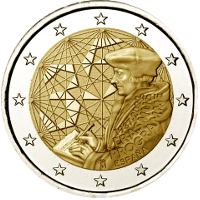 🔎
🔎 |
 |
Spain | 01 Jul. 2022 | 35th anniversary of the Erasmus Program |
20003 20005 20009 |
1,018,500 |  |
National characteristics : The quarter circle at the bottom right has four lines; below the commemorative period, the occasion of issue "ERASMUS PROGRAMME" (in English) is written in two lines, below which is the issuing country "ESPAÑA" (Spain). A crowned "M" is depicted at the bottom on the left sleeve as the mint mark of the Spanish mint Real Casa de la Moneda in Madrid. |
|||||||
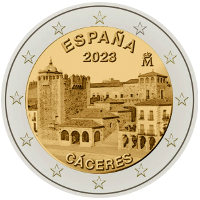 🔎
🔎 |
 |
Spain | 28 Mar. 2023 | Old Town of Cáceres 14th coin in the UNESCO Wourld Heritage Sites series |
20003 20005 20009 |
1,500,000 |  |
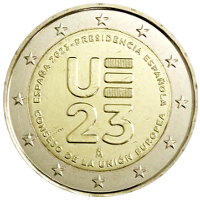 🔎
🔎 |
 |
Spain | 03 Jul. 2023 | EU Presidency 2023 |
20003 20008 20009 |
1,500,000 |  |
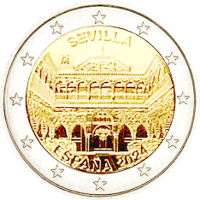
|
 |
Spain | 02 Feb. 2024 | Cathedral, Alcazar und Archivo de Indias in Seville 15th coin in the UNESCO Wourld Heritage Sites series |
20003 | 1,500,000 |  |
 Work in progress |
|||||||
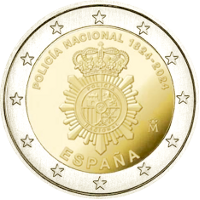
|
 |
Spain | 02 Feb. 2024 | 200 years of the Spanish National Police | 20003 | 1,500,000 |  |
 Work in progress |
|||||||
| References : | |||
| 20001 | Images taken with authorisation by the ECB ‐ Mail dated 20.Feb.2020 © "European Central Bank" |
20002 | Data mirrored from Wikipedia Page "2_euro_commemorative_coins" with friendly support of the guardians of that page. |
| 20003 | Images taken with authorisation by H....... Hamburg | 20004 | Coloured version of this Commemorative Coin in circulation EU‐legal‐technical specifications do not recongnise colour prints. The EU nevertheless tolerates them, as their numbers are very small and they are sold in special packs and therefor are very unlikely to be used as currency. |
| 20005 | enlarged Images taken with authorisation by Gerd Seyffert © "Gerd Seyffert 2021" |
20006 | Not Applicable |
| 20007 | Images taken by Münzen Kreuzberg © "Münzen Kreuzberg 2021" |
20008 | enlarged Images taken by Münzen Kreuzberg © "Münzen Kreuzberg 2021" |
| 20009 | Text with kind permission by Gerd Seyffert © "Gerd Seyffert 2023" |
20010 | Not Applicable |
 |
